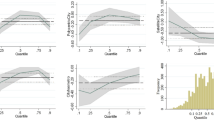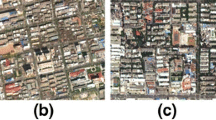Abstract
This paper aims to investigate the impact of the built environment (BE) and emerging transit and car technologies on household transport-related greenhouse gas emissions (GHGs) across three urban regions. Trip-level GHG emissions are first estimated by combining different data sources such as origin–destination (OD) surveys, vehicle fleet fuel consumption rates, and transit ridership data. BE indicators for the different urban regions are generated for each household and the impact of neighborhood typologies is derived based on these indicators. A traditional ordinary least square (OLS) regression approach is then used to investigate the direct association between the BE indicators, socio-demographics, and household GHGs. The effect of neighborhood typologies on GHGs is explored using both OLS and a simultaneous equation modeling approach. Once the best models are determined for each urban region, the potential impact of BE is determined through elasticities and compared with the impact of technological improvements. For this, various fuel efficiency scenarios are formulated and the reductions on household GHGs are determined. Once the potential impact of green transit and car technologies is determined, the results are compared to those related to BE initiatives. Among other results, it is found that BE attributes have a statistically significant effect on GHGs. However, the elasticities are very small, as reported in several previous studies. For instance, a 10 % increase in population density will result in 3.5, 1.5 and 1.4 % reduction in Montreal, Quebec and Sherbrooke, respectively. It is also important to highlight the significant variation of household GHGs among neighborhoods in the same city, variation which is much greater than among cities. In the short term, improvements on the private passenger vehicle fleet are expected to be much more significant than BE and green transit technologies. However, the combined effect of BE strategies and private-motor vehicle technological improvement would result in more significant GHGs reductions in the long term.




Similar content being viewed by others
Notes
The city of Sherbrooke is the fourth largest metropolitan area in the province of Quebec (after greater Montreal, Quebec city and Gatineau, located in the south of the province.
National Inventory Report 1990–2009 (2011 submission), Environment Canada. (http://www.ec.gc.ca/ges-ghg/default.asp?lang=En&n=AC2B7641-1).
The Quebec government initially adopted its own standards for MY2009 to MY2016. These standards were similar to those adopted in California. However, the Quebec government recently announced that it will align its regulation to the Federal norms.
Specifically, we assume that the age structure of the fleet in 2021 will be the same as in 2008 and that the standards will be met at the level of the province. We also assume that the mix of sales across vehicle footprint for both cars and light trucks will be those observed for MY-2006 to MY-2008.
For comparison, the US DOE (US Department of Energy 2012) estimates that light trucks will account for 39 % of new LDV in 2025.
This is about the penalty used by NHTSA (compare Table I.B.2-1 and 2 of the Federal Register,)Federal Register 2010
The null hypothesis that the BE and car ownership variables are exogenous.
References
Ally, J., Pryor, T.: Life-cycle assessment of diesel, natural gas and hydrogen fuel cell bus transportation systems. J. Power Sources 170, 401–411 (2007)
Babin, A., Fournier, P., Gourvil, L.: Modèle d’émission des polluants et des GES et modèle de consommation des carburants pour MOTREM, Service de la modélisation des systèmes de transport, Ministère des Transports du Québec, p. 221 (2004)
Badoe, D., Miller, E.: Transportation-land use interaction: empirical findings in North America, and their implications for modeling. Transp. Res. 5(4), 235–263 (2000)
Barla, P., Lamonde, B., Miranda-Moreno, L.F., Boucher, N.: Traveled distance, stock and fuel efficiency of private vehicles in Canada: price elasticities and rebound effect. Transportation 36(4), 367–467 (2009)
Barla, P., Miranda-Moreno, L.F., Lee-Gosselin, M.: Urban travel CO2 emissions and land use: a case study for Quebec City. Transp. Res. Part D 16(6), 423–428 (2010)
Bento, A.M., Cropper, M.L., Mobarak, A.M., Vinha, K.: The effects of urban spatial structure on travel demand in the United States. Rev. Econ. Stat. 87(3), 466–478 (2005)
Castella, P.S., Blanc, I., Ferrer, M.G., Ecabert, B., Wakeman, M., Manson, J.-A., Emery, D., Han, S.-H., Hong, J., Jolliet, O.: Integrating life cycle costs and environmental impacts of composite rail car-bodies for a Korean train. Int. J. Life Cycle Assess. 14, 429–442 (2009)
Chester, M., Horvath, A.: Life-cycle assessment of high-speed rail: the case of California. Environ Res Lett 5(1), 014003 (2010)
Deb, P., Trivedi, P.K.: Specification and simulated likelihood estimation of a non-normal treatment-outcome model with selection: application to health care utilization. Econ J 9, 307–331 (2006)
Environnent Canada.: Environnent Canada’s online newsmagazine. Issue 100, Taming Transport: New Regulations for 30 Greenhouse. http://www.ec.gc.ca/envirozine/default.asp?lang=En&n=AB656AC7-13131 (2010)
Federal Register.: Light-duty vehicle greenhouse gas emission standards and corporate average fuel economy standards; final rule, http://www.gpo.gov/fdsys/pkg/FR-2010-05-07/pdf/2010-8159.pdf (2010)
Frank, L.D., Schmid, T.L., Sallis, J.F., Chapman, J., Saelens, B.E.: Linking objectively measured physical activity with objectively measured urban form: findings from SMARTRAQ. Am. J. Prev. Med. 28(2), 117–125 (2005)
Frey, H.C., Rouphail, N.M., Zhai, H., Farias, T.L., Goncalves, G.A.: Comparing real-world fuel consumption for diesel- and hydrogen-fueled transit buses and implication for emissions. Transp. Res. Part D 12, 281–291 (2007)
Hartgen, D., Gregory Fields, M., Moore, A. Impacts of transportation policies on greenhouse gas emissions in U.S. regions. Reason foundation, http://reason.org/news/show/greenhouse-gas-policies-cost-transp (2011)
Karman, D.: Life-cycle analysis of GHG emissions for CNG and diesel buses in Beijing. EIC Clim Change Technol 1, 248–253 (2006)
Lin, J., Long, L.: What neighborhood are you in? Empirical findings of relationships between household travel and neighborhood characteristics. Transportation 35(6), 739–758 (2008)
Marin, G.D., Naterer, G.F., Gabriel, K.: Rail transportation by hydrogen versus electrification—case study for Ontario Canada, I: propulsion and storage. Int J Hydrog Energy 35, 6084–6096 (2010a)
Marin, G.D., Naterer, G.F., Gabriel, K.: Rail transportation by hydrogen versus electrification—case study for Ontario, Canada, II: energy supply and distribution. Int J Hydrog Energy 35(12), 6097–6107 (2010b)
MDDEP.: Ministère du Développement durable, de l’Environnement et des Parcs du Québec, (2007)
Meegahawatte, D., Hillmansen, S., Roberts, C., Falco, M., McGordon, A., Jennings, P.: Analysis of a fuel cell hybrid commuter railway vehicle. J. Power Sources 195, 7829–7837 (2010)
Miranda-Moreno, L., Bettex, L., Zahabi, A., Kreider, T., Barla, P.: A simultaneous modeling approach to evaluate the endogenous influence of urban form and public transit accessibility on distance traveled. J Transp Res Record 2255, 100–109 (2011)
Plan d’action.: sur les vehicules electriques, (2011–2020). http://www.mrn.gouv.qc.ca/publications/energie/strategie/plan-action.pdf
Riva, M., Apparicio, P., Gauvin, L., Brodeur, J.-M.: Establishing the soundness of administrative spatial units for operationalising the active living potential of residential environments: an exemplar for designing optimal zones. Int J Health Geogr 7(1), 43 (2008)
Rozycki, V.C., Koeser, H., Schwarz, H.: Ecology profile of the german high-speed rail passenger transport system, ICE. Int. J. Life Cycle Assess. 8(2), 83–91 (2003)
Schafer, A., Heywood, J.B., Weiss, M.A.: Future fuel cell and internal combustion engine automobile technologies: a 25-year life cycle and fleet impact assessment. Energy 31, 2064–2087 (2006)
Smith, R.A.: Railways: how they may contribute to a sustainable future. Proc Inst Mech Eng Part F 217, 243–248 (2003)
Société de transport de Montréal (STM).: Technical Report-Hybrid Technology, (2009)
Statistics Canada.: 2001 Census of Population, Montréal (862 areas). E-STAT (distributor), (2001)
Theil, H., Finizza, A.J.: A note on the measurement of racial integration of schools by means of informational concepts. J Math Sociol 1(2), 187–193 (1971)
TRB-Transportation Research Board.: Driving and the built environment: the effects of compact development on motorized travel, energy use, and CO2 emissions. Special Report 298, National Research Council, Washington DC, (2009)
US Department of Energy.: Annual Energy Outlook 2012 with projections to 2035, www.eia.gov/forecasts/aeo (2012)
Wee, B.V., Janse, P., Van Den Brink, R.: Comparing energy use and environmental performance of land transport modes. Transp Rev 25(1), 3–34 (2005)
Zahabi, SAH., Miranda-Moreno, LF., Patterson, Z., Barla, P.: Urban transportation greenhouse gas emissions and its link with urban form, transit accessibility and emerging green technologies: a montreal case study. In: Transportation Research Board 92nd Annual Meeting, no. 13-1394, (2013)
Zahabi, S.A.H., Miranda-Moreno, L., Patterson, Z., Barla, P.: Spatio-temporal analysis of car distance, greenhouse gases and the effect of built environment: a latent class regression analysis. Transp. Res. Part A 77, 1–13 (2015)
Zamel, N., Li, X.: Life cycle analysis of vehicles powered by a fuel cell and by internal combustion engine for Canada. J. Power Sources 155, 297–310 (2006)
Acknowledgments
We would like to acknowledge the financial aid provided by Ministère des Transports du Québec (MTQ) and FQRNT. We would also like to thank the AMT and MTQ for providing us with the data necessary for this research, including O-D surveys.
Author information
Authors and Affiliations
Corresponding author
Rights and permissions
About this article
Cite this article
Zahabi, S.A.H., Miranda-Moreno, L., Patterson, Z. et al. Impacts of built environment and emerging green technologies on daily transportation greenhouse gas emissions in Quebec cities: a disaggregate modeling approach. Transportation 44, 159–180 (2017). https://doi.org/10.1007/s11116-015-9631-0
Published:
Issue Date:
DOI: https://doi.org/10.1007/s11116-015-9631-0




